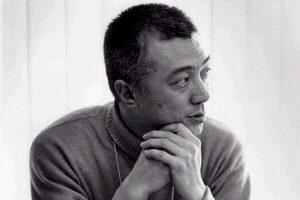Hiroshi Teshigahara facts for kids
Quick facts for kids
Hiroshi Teshigahara
|
|
|---|---|
 |
|
| Born | January 28, 1927 |
| Died | April 14, 2001 (aged 74) Tokyo, Japan
|
| Alma mater | Tokyo National University of Fine Arts and Music, Tokyo, Japan |
| Occupation | Film director |
|
Notable work
|
|
| Movement | Japanese New Wave |
| Spouse(s) | Toshiko Kobayashi |
| Relatives | Sofu Teshigahara (father) |
Hiroshi Teshigahara (勅使河原 宏, Teshigahara Hiroshi, January 28, 1927 – April 14, 2001) was a famous Japanese filmmaker and artist. He was known for making unique and artistic movies. He was part of a group of filmmakers called the Japanese New Wave. His most famous film is Woman in the Dunes, which came out in 1964. People often call him "one of the most acclaimed Japanese directors of all time."
Teshigahara was the first person of Asian descent to be nominated for the Academy Award for Best Director. This happened in 1964 for his work on Woman in the Dunes. Besides making films, Teshigahara also loved other arts. These included calligraphy (beautiful writing), pottery, painting, opera, and ikebana (the Japanese art of flower arranging).
Contents
About Hiroshi Teshigahara's Life
Hiroshi Teshigahara was born in Tokyo, Japan. His father, Sōfu Teshigahara, was the founder of the Sōgetsu-ryū school of ikebana. This is a well-known style of Japanese flower arranging.
Hiroshi finished his studies in 1950 at the Tokyo National University of Fine Arts and Music. After that, he started making documentary films.
Early Films and Collaborations
In 1962, Teshigahara directed his first major film, Pitfall. He worked on this movie with writer Kōbō Abe and musician Toru Takemitsu. Pitfall won an award for new directors from NHK, a Japanese broadcasting company.
Throughout the 1960s, he kept working with Abe and Takemitsu on more films. At the same time, he also worked on his passion for ikebana and sculpture.
Woman in the Dunes and Awards
In 1965, Teshigahara's film Woman in the Dunes (made in 1964) was nominated for an Academy Award for Best Foreign Language Film. It also won a special award at the Cannes Film Festival in France.
The original version of Woman in the Dunes was 147 minutes long. But Teshigahara shortened it to 124 minutes for the Cannes Film Festival.
In 1972, he made a film called Summer Soldiers. This movie was about American soldiers who left the army during the Vietnam War. It showed their lives in Japan.
Later Career and Art
From the mid-1970s, Teshigahara made fewer feature films. He focused more on documentaries and art exhibitions. He also spent more time on the Sogetsu School of ikebana. In 1980, after his father passed away, Hiroshi became the third grand master of the Sogetsu School.
As grand master, Teshigahara used bamboo in his large art shows. These shows were held in famous museums around the world. Some places included the National Museum of Contemporary Art in Seoul, Korea (1989), and the Kennedy Center in Washington, D.C. (1996). In Japan, his art was shown in many cities like Marugame and Hiroshima.
In the 1990s, he explored a new art form called renka. This is where several artists create ikebana arrangements together, one after another. Teshigahara was also involved in ceramics, calligraphy, and installation art.
Throughout his career, Teshigahara also directed stage plays and operas. He directed the opera Turandot in France and Switzerland. He also directed traditional Japanese Noh plays and dance performances.
Art Collections
In 1983, Hiroshi Teshigahara created a permanent art display. You can find it at the Ken Domon Museum in Sakata, Japan.
Death and Legacy
Hiroshi Teshigahara passed away on April 14, 2001, in his hometown of Tokyo, Japan. He was 74 years old.
One year after his death, on April 14, 2002, a special collection of his best-known films was released on DVD in Japan. This was done to honor his memory.
Filmography
Here is a list of films Hiroshi Teshigahara worked on:
- Hokusai (北斎, 1953)
- 12 Photographers (十二人の冩真家) 1955
- Ikebana (いけばな, 1957) – director and screenplay
- (有楽町0番地, 1958) – screenplay
- Tokyo 1958 (東京1958, 1958)
- (海は生きている, 1958) – art
- José Torres (ホゼー・トレス, 1959) – director and shooting
- Pitfall (おとし穴, 1962) – director
- Sculptures by Sofu-Vita (いのち ―蒼風の彫刻, 1962) – director
- Woman in the Dunes (砂の女, 1964) – director
- White Morning (白い朝, 1965)
- Jose Torres Part II (ホゼー・トレス Part II, 1965)
- The Face of Another (他人の顔, Tanin no Kao, 1966) – director
- Bakusō (爆走, 1966)
- (インディレース 爆走, 1967) – producer
- The Man Without a Map (燃えつきた地図, Moetsukita Chizu, 1968) aka The Ruined Map (燃えつきた地図) – director
- 240 Hours in One Day (1日240時間, 1970)
- Summer Soldiers (サマー・ソルジャー, 1972) – director, planning and shooting
- Warera no Shuyaku (われらの主役, 1977) – TV film
- Shin Zatōichi – Episode: Journey of Rainbows (新座頭市「虹の旅」, 1978) – TV film
- Shin Zatōichi – Episode: Journey of Dreams (新座頭市「夢の旅」, 1978) – TV film
- Sculpture Mouvante – Jean Tinguely (動く彫刻 ジャン・ティンゲリー, 1981)
- Antoni Gaudi (アントニー・ガウディー, 1984) – director, producer and editing
- Rikyu (利休, 1989) – director, producer and screenplay
- Princess Goh (豪姫, 1992) aka Basara – The Princess Goh – director, producer and screenplay

